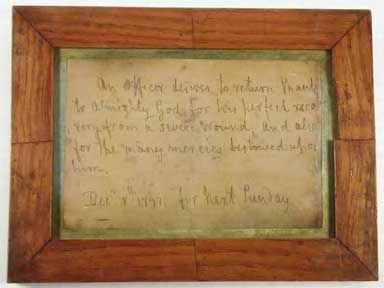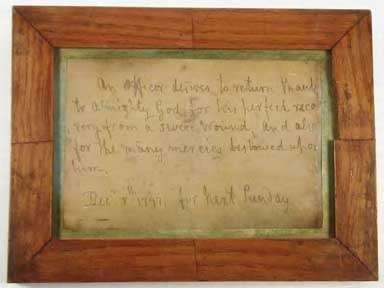
Lot 191

NELSON Vice Admiral Horatio, Viscount


Auction: 1 February 2005 at 11:00 GMT
Description
Autograph note (unsigned) probably to the Revd. Joshua Greville, the incumbent of St. George's Church, Hanover Square, London, 8 December, 1797, giving thanks for "his perfect recovery from a severe wound, and also for the many mercies bestowed upon him", one page, 10 x 18 cms. Contained within a glazed frame described as being made from the wood of the main mast of HMS Victory
Note: For information about the recipient The Revd. Joshua Greville see Alumni Oxonienes.
Nelson' right arm was amputated in the early morning of 25 July 1797. Once home, plans to spend the winter in Bath were dropped in favour of going to London to consult surgeons. The Nelsons took lodgings at 141 Bond Street. By December, time and nature had done much to heal the wound which was further helped by the removal of the ligature in November. "During the first week of December, the Nelsons walked round the corner from Bond Street to their local church, St. George's, Hanover Square, and left a brief thanksgiving prayer for the parson to read aloud on the follow Sunday". (Pocock p. 148, who quotes the text of the prayer, but without indicating his source)
The note is also quoted in full by Nicolas (The Dispatches and letters of Lord Nelson, vol. 2 p. 455 - this presumably being Pocock's source). Nicolas gives his source as being a "facsimile" which had been in the possession of the family of the Revd. Joshua Greville. This inevitably raises a question as to the nature of the present document. Clearly the original note was intended for Greville for him to read out on the Sunday. For there to be a "facsimile" there had to be an original. That the original was retained by Greville is also clearly understandable - Nelson was by 1797 an adored national hero. The existence of the note was sufficiently well known for it to be included in Nicolas's edition. It is more than likely that by the time of Nicolas's compilation, copies existed and it is perhaps worthwhile noting that Nicolas uses the past tense when speaking of the copy as having been in the possession of the Greveille family which, of course, does not preclude there being in possession of the original.
In favour of the present note's authenticity are (a) its direct link to the Greville family supported by the information on the verso of the frame where it is described as "The note sent by Lord Nelson", and (b) the note from Greville's son recording the transfer from himself to Sir William Fraser dated Nov 30th, 1867 also to be found pasted onto the verso. In addition, part of the backing has the appearance of having been opened, presumably for inspection of the note by Sir William and the split resulting from the opening has been closed with his paper seal. But perhaps the most telling piece of evidence is the physical appearance of the document itself, with the piece of paper being added to the irregular right hand edge of the note to square it off for framing. A facsimile would not show such a feature.
Nelson, of course, was the son of a clergyman as were at least a dozen of his family, including his brother, and immediate forebears. His religious beliefs and influences were deep-laid. As a young man, he experienced a profound moment of spiritual experience while recovering from depression after illness during his voyage on the Seahorse in 1775 when he became so ill he was not expected to live. "Although the experience was not overtly religious … this clergyman's son had, on board a ship somewhere in the South Atlantic, been touched by the same inspired omnipotence. He was never to forget it and never to lose the confidence and drive that it gave him." (Pocock p. 21)
Pocock p. 325 also notes "his reliance upon Providence and prayer and the private relationship with the deity which, he felt overrode the conventions of public morality". Perhaps, above all, this reliance expressed itself in the prayer he wrote on the morning of the battle of Trafalgar in which he committed his life "to Him who made me and may His blessing light upon my endeavours for serving my Country faithfully. To Him I resign myself and the just cause which is entrusted me to defend. Amen, amen, amen." The present letter provides an intimate insight into that faith and it is, of course, all the more revealing for its being written in the third person and anonymously.
Nelson made remarkable progress with the use of his left hand. "One would expect some change if writing with a change of hand. Apart from anything else, the angled mechanics of propelling the pen along the paper are altered. But the alteration in Nelson's case was dramatic … Before the amputation, his handwriting was a fairly conventional one for the time, being a fluid cursive, sloping to the right. Afterwards, when forced to write with his left hand, his writing becomes squarish with a tendency to slope backwards. It would be difficult to confuse it with any other hand of the period." (Pryor "Nelson the letter-writer" in White The Nelson companion p. 167)
Provenance: As above with Fraser's bookplate on the verso and a note by Fraser referring to his purchase of the letter from the Revd. Joshua Greville's son. Over the verso is an additional later wooden backing, probably added by Fraser, to protect the original backing which has (1) a receipt dated Nov 30 1867 from P.G. Greville to Fraser (2) A further description in an unidentified hand (3) a small blue label bearing Fraser's name and device, and a note by P.G. Greville that the frame was made of wood from the main mast of the Victory which was given to his father by a medical officer on board the ship at the time of Nelson's death.

